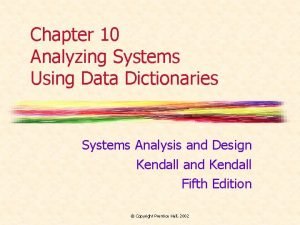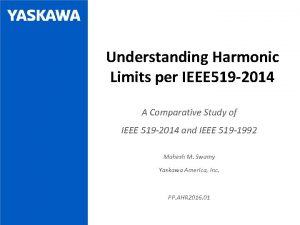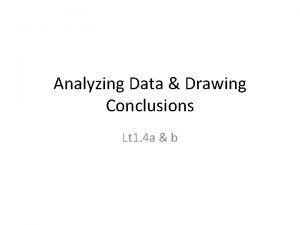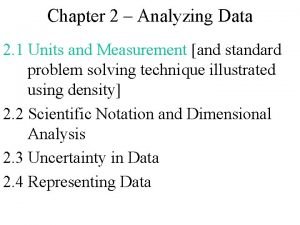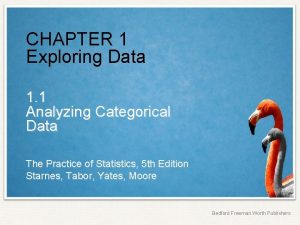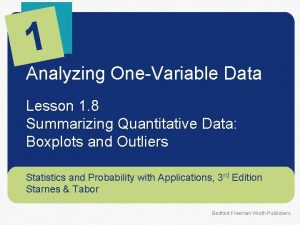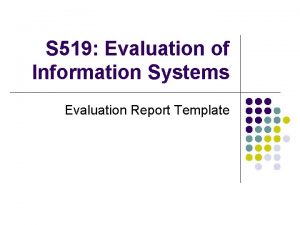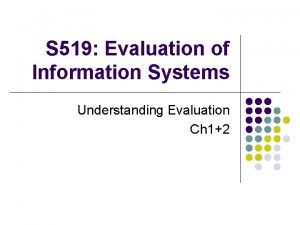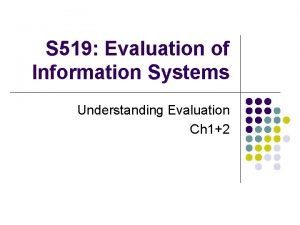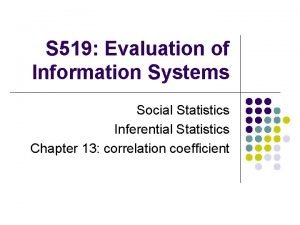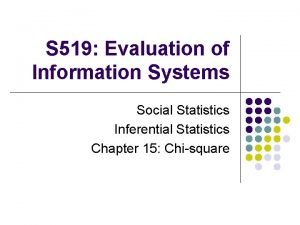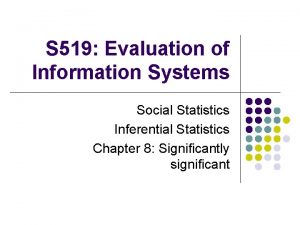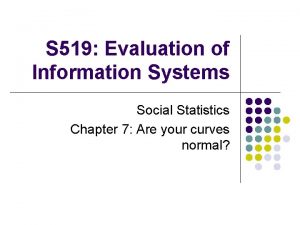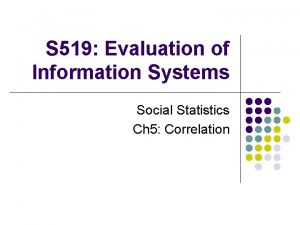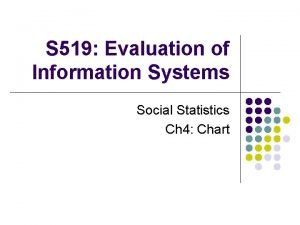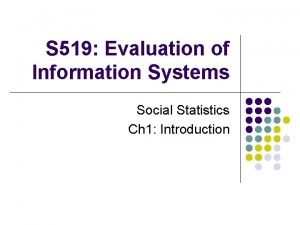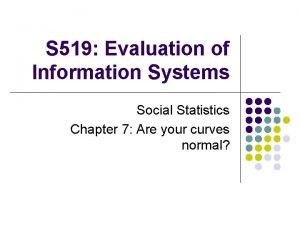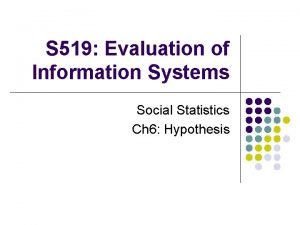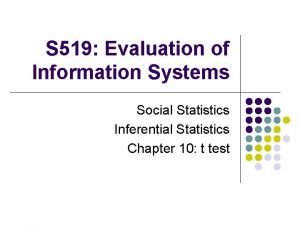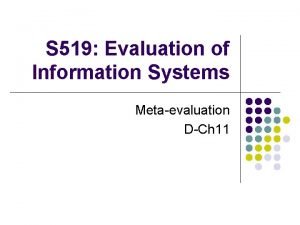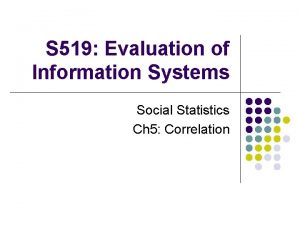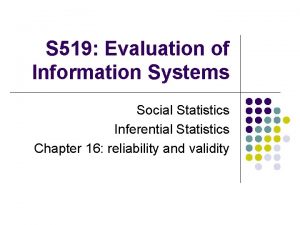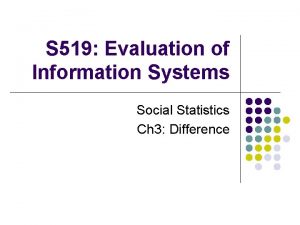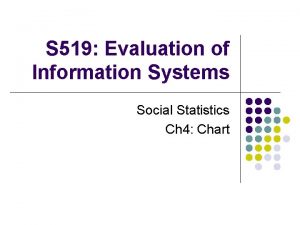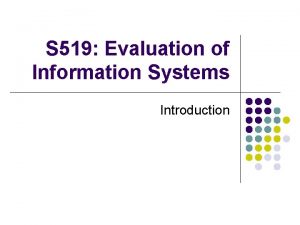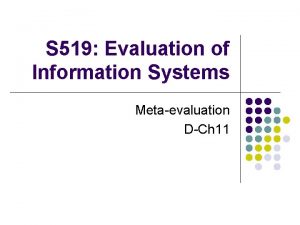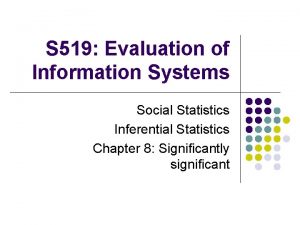S 519 Evaluation of Information Systems Analyzing data

























- Slides: 25

S 519: Evaluation of Information Systems Analyzing data: Merit Ch 8

Last week l l What are 6 strategies to determine the importance. Pros and cons of them (Table 7. 10)?

Merit determination l Keep in mind of what the evaluation is. l l Evaluation is the systematic determination of the quality or value of something (Scriven, 1991). Today we will discuss how to determin the importance of evaluand components or dimensions

Merit determination l It is the process of setting „standards“ (definitions of what performance should constitute „satisfactory“, „good“, etc. ) and applying those standards to descriptive data to draw explicitly evaluative conclusions about performance on a particular dimension or component.

Two steps l l Step 1: defining what constitutes poor, adequate, good, very good and excellent performances on a particular dimension (or component) Step 2. using this definition to convert empirical evidence into evaluative conclusions (e. g. something explicit about quality or value)

Determing merit Decscriptive facts about performance Quality or value determination guide Evaluative conclusions

Usingle quantitaive measure l In a simple case, performance is measured on a single quantitative dimension l The quality or value determination guide is just a set of cutoffs l l l E. g. , >90%=A/excellent, 80%-89%=B/good, 70%79%=C/adequate E. g. , satisfactory/unsatisfactory Difficulty: where to put the cutoff score and how to compare with different systems?

Exercise l School grading system l l l USA: A(>90%), B(80 -90%), C(70 -79%), D(60 -69%), F(<60%) New Zealand: A(>80%), B(65 -79%), C(50 -64%), D(3549%), F(<35%). Does that mean in New Zealand, it is easier to get A? Can this way of grading ensure objectivity and consistency of grading across courses? If yes, why? If no, why not? What happens in your country? Form a group to discuss

Using qualitative or multiple measures l l l Using a single measure is not generally good practice. When using multiple measures, it is tricky on how to merge them together to come out with conclusion. See table 8. 1

Experience l l Do not try to go for high precision It is perfectly appropriate to give an answer that still has a certain amount of fuzziness or uncertainty associated with it. Please do not oversell the precision of your work Providing a well-supported broad-brush answer to an important question is not a bad idea.

Rubric l l Rubric is a tool that provides an evaluative description of what performance or quality „looks like“. It has two levels: l l Grading rubric is used to determin absolute quality or value (e. g. , Table 8. 2) Ranking rubric is used to determin relative quality or value

Rubric for absolute value l Rubric for “grading” is based on: l l l Discussion with domain expert Discussion with upstream stakeholders Existing rules (scope of duties) or literatures Evaluand expectations (needs assessment) Evaluation context (job market, current situation)

Sample grading rubric 1 l l Table 8. 3 Using Table 8. 3 to grade Table 8. 1 – what is grade for this master program? Why? Do it by yourself first? Form a pair and discuss your point

Sample grading rubric 2 l Table 8. 4 provides you a better grading rubric l l Scope Performance indicators Ranking (1 -5) Discuss l How do they develope rank baesd on performance indicators

Exercise l Refine Table 8. 3 l l Identify scopes Identify performance indicators Refine the ranking according to identified indicators. Form a group and discuss

Exercise l Develop a grading rubric for your evaluation project l Take Table 8. 4 as example l Please include scope, performance indicators and ranking description

Using rubric for determining „relative“ merit l Relative metric is important for experiment that uses a control or comparison group. l l Student scores are interpreted by comparison with other similar schools It simily tell us how the person or program did relative to peers or competitors.

Using rubric for determining „relevative“ merit Score falls in Grade assigned Top 10% A Next 20% B Next 50% C Next 15% D Next 5% F “Grading on the curve”: instructors rank students into different percentage E. g. : GRE, SAT, GMAT, IQ

Significance l Statistical significance: l l Any observed difference (or statistical relationship) is unlikely to be due to chance Practical significance: l Real impact on people‘s life l l E. g. , the difference has a noticeable and nontrivial effect on functioning or performance When determining the merit of a particular outcome, we should taken both significance into consideration

Relative merit l Using comparison to determine relative merit l Benchmark process, outcome, and cost criteria against what has been achieved elsewhere (e. g. by other evaluands of a similar setting).

Benchmarking l l It is a systematic study of one or more other organizations‘ systems, processes, and outcomes to identify ideas for improving organizational effectiveness. It refers to a process of gathering comparison data about what organizations in similar or related industries are achieving (e. g. About process, outcomes, and costs). l l Quantiative data Qualitative data (observation of processes)

Exercise l Grading Table 8. 8 according to the rubric in Table 8. 7 l l What is your grading Why is it? How can you improve table 8. 7? Form a group to discuss

Exercise l Take the grantsmanworkshop, draw the absolute and relative rubrics to grade this training program l l Absolute rubric (see Table 8. 4) Relative rubric (see Table 8. 7) Write down half page Form a group to discuss

Lab Exercise l Draw the absolute and relative rubric for your evaluation project l l l Work together with your project team Absolute rubric (see Table 8. 4) Relative rubric (see Table 8. 7)

Some hints l l Keep an open mind Any help that can help you to make good sense of the data Balance of time and effort Balance of time and level of details
 Example of data dictionary in system analysis and design
Example of data dictionary in system analysis and design Point of common coupling (pcc)
Point of common coupling (pcc) Cis 519
Cis 519 Cis 419 upenn
Cis 419 upenn Upenn cis 519
Upenn cis 519 Ieee-519
Ieee-519 Cs 519
Cs 519 Cs 519
Cs 519 What is gnp and gdp
What is gnp and gdp L1111l
L1111l Cis 419 upenn
Cis 419 upenn Analyzing and using marketing information
Analyzing and using marketing information Analyzing conflicting information
Analyzing conflicting information Marketing information and customer insights are
Marketing information and customer insights are Analyzing ethnographic data
Analyzing ethnographic data Making conclusions from analyzed data
Making conclusions from analyzed data Chapter 2 analyzing data
Chapter 2 analyzing data Chapter 2 analyzing data answer key
Chapter 2 analyzing data answer key Analyzing and visualizing data with microsoft power bi
Analyzing and visualizing data with microsoft power bi Interpreting quantitative data
Interpreting quantitative data Analyzing categorical data
Analyzing categorical data Analyzing one variable data
Analyzing one variable data Experimental design in quantitative research
Experimental design in quantitative research Analyzing and interpreting data in research
Analyzing and interpreting data in research Analyzing and interpreting data in research
Analyzing and interpreting data in research Analyzing and interpreting data in research
Analyzing and interpreting data in research
